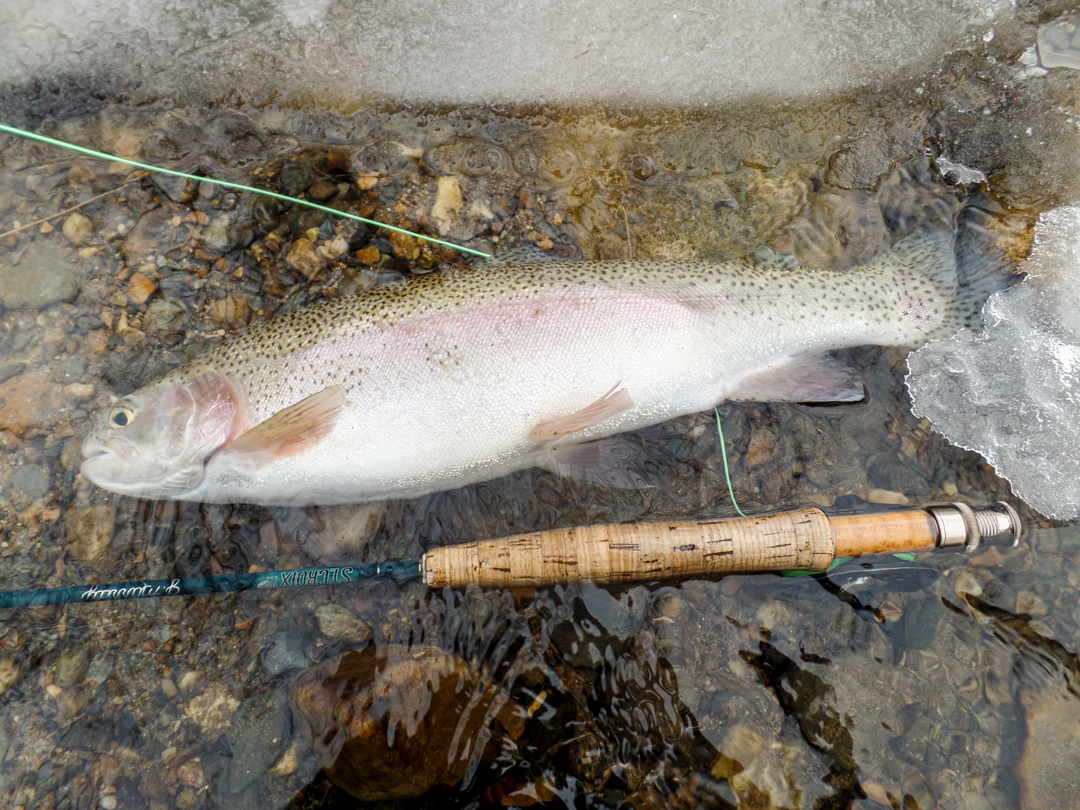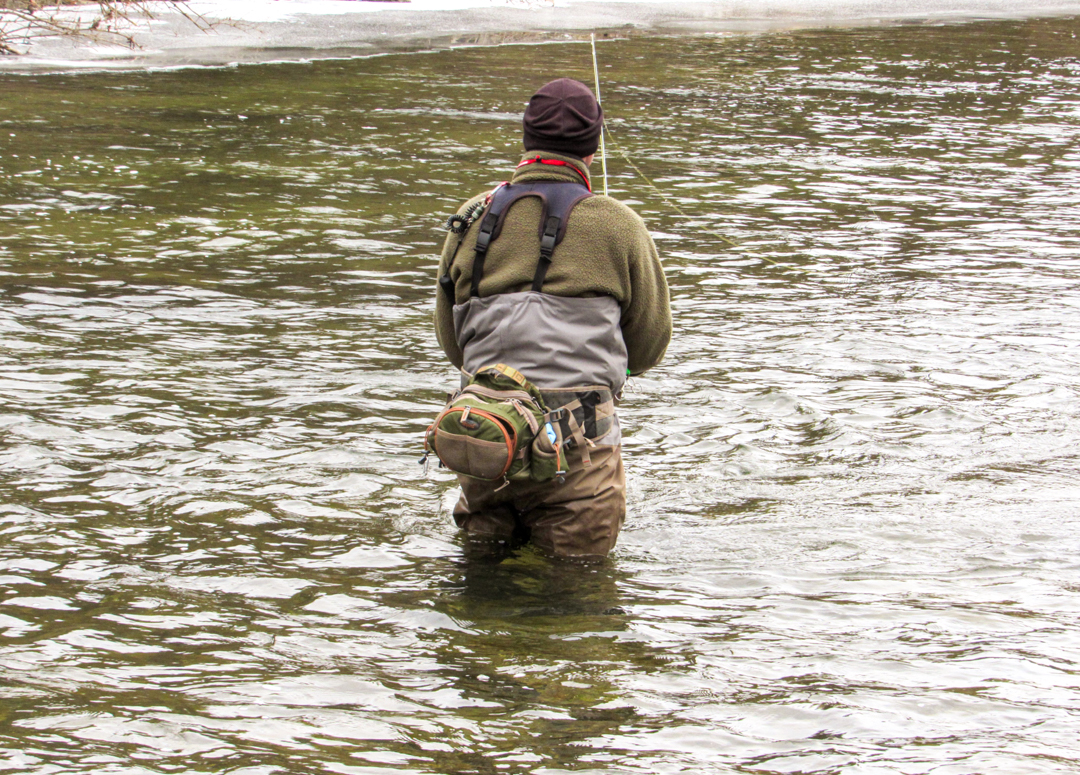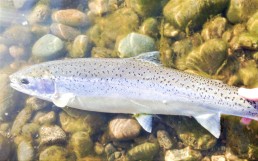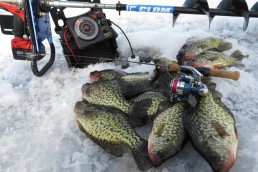Swinging for Winter Steelies
SHARE THIS POST
Accumulating snow and ice combined with brutally cold temperatures create a challenging fishing environment for pursuing steelhead. Winter steelhead fishing is certainly not a sport for the faint of heart, and only the most dedicated anglers willingly venture into this unforgiving arena. The frigid winter conditions are painful to the human body, and the cold water dramatically slows the steelhead’s metabolism, effectively reducing their need to feed. This is certainly not a good combination for fishing success.
Veteran anglers who participate in this winter venture compare the experience with attending a dysfunctional birthday party: The birthday cake is there, but the lackadaisical host may not put cake on your plate. Most certainly, the steelhead are there, but connecting with one at the end of your line can be another matter entirely.

Frustrated anglers
These fish are sluggish because of the cold water, and seemingly disregard former conventional offerings as if they are now blind. Yet, many stubborn anglers continue to use the same techniques that brought fish to the net during the fall season. It worked before, so with unwavering persistence, they surmise it will work again. Unfortunately, the steelhead aren’t following the rules in the game playbook, and no matter how hard it is hit, the hammer won’t put a square peg into a round hole to solve a puzzle dilemma.
The end result is, the steelhead will ignore the persistent angler’s formerly successful presentations, resulting in total frustration. It is still very possible to entice those steelhead into striking with a change in tactics. With frigid winter fishing, it is truly the angler’s only hope.

Start swinging
Unlike a complicated dance move from past days, swinging is a simple fishing tactic. This swinging tactic requires fishing in moving water—and preferably not very deep. If water depth permits, anglers need to position themselves in the near center of the stream while facing downstream in knee- or waist-deep runs of moving water. Long riffle sections of the stream at the tops of pools are good locations as well, and lengthy tail-outs of pools are equally effective.
Cast down and across at a near 45-degree angle towards the streambank, and then point the tip of the rod down toward the center of the stream. The presentation will start drifting downstream while beginning to swing outward. This swinging motion will often entice the attention of lethargic steelhead. If a strike doesn’t occur at the end of the swing, let the presentation flutter in the current for a few minutes.
If a steelhead does not strike after a few minutes, start a very slow upstream retrieve to move the presentation upstream two to three feet, and then stop and hold again for a few minutes. Like a cat being mesmerized by a toy mouse on a string, most steelhead cannot resist the concept of the presentation escaping upstream. Repeat the cast and technique after taking a few steps downstream to show the presentation to another potential steelhead.
Are you enjoying this post?
You can be among the first to get the latest info on where to go, what to use and how to use it!
A fly or spinning rod both perform well when swinging
Swinging is an equal opportunity fishing technique for either spinning rod or fly anglers. When using a fly rod, a 6- to 8-weight floating fly line preforms well while using a leader length that’s 7 1/2 to 9 feet in length. Fly anglers shouldn’t go too light in leader/tippet strength, because the steelhead hit the flies pretty hard when the swinging maneuver is used. Plus, the downstream water flow puts additional stress on the leader/tippet material. The best choice is 4X or 3X—approximately 6- to-8-pound test, depending on the product brand selected. Medium action nine-to-ten-foot fly rods are a good choice, which have a softer tip section to help cushion the strikes, turns and runs. Keep the fly rod up during the ensuing battle to help protect the leader and tippet. The fly reel should have a smooth, lightly set drag to allow for the sudden acceleration of the hooked steelhead.
Spinning rod anglers should use a soft-tipped long rod to help cushion the fighting weight of the steelhead. Fishing reels must have a good drag system, set light for bursts of acceleration, and spooled with 6-to-8-pound test monofilament. This stronger monofilament will also help prevent break offs that can occur with the hard strikes and sudden runs.
Whether using a fly rod or spinning rod, be advised that steelhead—even lethargic, cold-water winter steelhead—become a burst of chrome lightning after being hooked. This uncanny power can catch anglers off guard, and unfortunately results in rapidly losing the steelhead. This isn’t the reward anglers deserve after immersing themselves in frigid water during the winter months. To avoid losing a steelhead, keep the drag loose, rod tip raised, and let the silver torpedo run after being hooked. Once that impressive burst of initial energy is expelled, a steelhead becomes much more manageable to get into the net.
Go big or go home
Using small flies and lures are often effective for steelhead that are actively feeding—but the key words here are “actively feeding.” But in this case, with cold water winter steelhead that aren’t feeding, you want to trigger impulse strikes. To trigger that impulse strike, get the immediate attention of a lethargic winter steelhead with a big fly or lure. Some of the best flies to use for this swinging technique have additional movement incorporated into the design of the fly, such as a large, marabou tail wooly bugger or a large rabbit strip streamer. Three- to 4-inch-long flies with a size 2 or 4 hook are perfect choices for lethargic winter steelhead.
For spinning rod lures, use the effectiveness of a large Mepps spinner or 3- to 4-inch-long stick bait. Big spoons in silver or gold color will also get the attention of steelhead and are worth a try. If regulations allow on your stream of choice, using a 3-inch emerald shiner with split shot clamped a couple feet up on the line; it works very well with the swinging technique. Use a size 4 hook and insert the hook through the head/lip section.
Be sure to try swinging for winter steelies during the next winter fishing trip to a stream. It’s an effective technique that will put some nice winter steelhead into your net—something that every diehard winter steelhead angler deserves after a cold day on the water.
MWO
SHARE THIS POST
Did you enjoy this post?
You can be among the first to get the latest info on where to go, what to use and how to use it!
John Murray
John Murray has a passion for the outdoors. A former professional fly tyer and fishing shop owner for more than a decade, John is a member of the NYS Outdoor Writers Association and is determined to share an acquired lifetime of knowledge to help everyone become proficient hunters and anglers.



